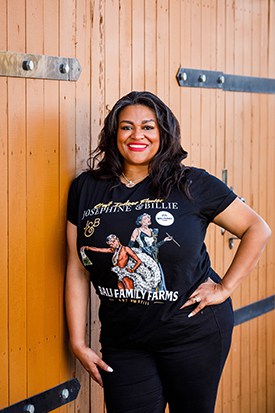How I Became Dubbed the ‘Olivia Pope’ of Cannabis
Marijuana Industry News February 16, 2022 MJ Shareholders

© Vanessa Stump
I never intended to get into the cannabis industry.
I worked as an Urban Planner managing the Natural Resource Program for the County of Ventura, California, where I oversaw the surface mining and oil and gas programs. After moving back to the Inland Empire, where I grew up, I ended up consulting for a city that embraced the idea of commercial cannabis licenses. And before I knew it, I found myself looking at land-use issues around cannabis.
I quickly realized that cannabis would primarily be a land-use issue, a world I knew very well. I managed several dozen cannabis projects, including cultivation sites, extensive manufacturing facilities, distribution centers, and retail locations in California, and I consulted on projects in Washington, Oklahoma, and Nevada. Then I started working with policy and permitting and quickly found legacy operators who needed help with licensing and compliance.
The approach that I’ve always taken is bridging the gap between the regulatory body and operators. Because especially with cannabis, though I’ve seen it in oil and gas too, you are working with individuals who previously hid from the government. The harm that came from cannabis prohibition, particularly in the black community, and how police enforced it has been disproportionate. I don’t think anyone would argue that, but what happens is it builds mistrust on both sides, rightfully so on one side.
So, we have operators who did not want to come forward because they didn’t trust that the government would legitimately give them a license. The social equity process itself was long, daunting, and convoluted. Plus, don’t forget that this transition requires legacy operators to go from having no regulations to having an oppressive number to keep up with. It’s complicated.
Due to my expertise, I quickly became known as the “Olivia Pope of Cannabis,” solving the complex problem of bringing legacy operators into compliance within the new social equity framework. I spent much of my time in the early parts of legislation convincing them that this is the way, the only way, that this is going to work. I was able to get operators to open up their doors and say, “We’ll let you in. We’ll show you what this looks like.”
But then the government turns around and slams them with additional taxes, taxing you for this and adding fees for that. And on and on and on! It almost feels like a slap in the face to these legacy operators. They opened up, volunteered to come forward, and said, “Let’s get a license instead of operating on the traditional side—we want to participate.” You see hundreds of operators all the time on the state’s Capitol steps saying, “We want to do the right thing.” It would help if the government came to the table with a spirit of collaboration, but it’s not happening that way. So, we’re seeing many operators feeling very disenfranchised, like their voices don’t matter, and we’ve seen what happens when people feel like their voices don’t matter.
I think many folks got into cannabis not to be part of “corporate America” but to fight against it and the corporate machine with its regulations, taxes, and exorbitant fees. Despite our cultural differences, this industry has always been for the people by the people. And this may be controversial, but I think Los Angeles’ Department of Cannabis Regulation (DCR) feels the same way.
There’s some misconception about DCR: That they’re not cannabis-friendly or aren’t a great ally for the cannabis community; that they make it difficult. And that couldn’t be further from the truth. I have met Executive Director Cat Packer and Social Equity Program Director Dr. Imani Brown; they’re actually very supportive of cannabis and the industry in and of itself. But more importantly, they’re supportive of the businesses. The problem is that DCR is experiencing the same thing industry is: they have an incredible workload and minimal resources. They’re also working with an industry that’s brand new in a time that is brand new. None of us has lived through a pandemic and all of the challenges that accompany it. Yet, the expectation is that somehow DCR can magically solve all the cannabis problems.
I’d argue DCR is not the problem; the system is the problem. Like many of America’s economic systems, cannabis licensing policies are designed to be more beneficial for those best prepared to operate in a regulatory framework. That means the laws reward the most wealthy. No one can argue that bureaucratic red tape doesn’t create barriers to entry for everyone. For some those barriers are navigable with the right resources. But when you don’t have access to the appropriate resources, those barriers become permanent.
I believe we need to focus on changing the system to get the outcomes we want to see. DCR is doing the best it can. They don’t have all of the answers; none of us do. But they’re trying to do better, shortening the application, streamlining processing, and figuring out how to protect equity businesses. I think they’ve done a fantastic job trying to protect the industry, particularly social equity businesses, from predatory practices, due to how the regulations were initially set up. Theory and practice are different, but you have to give an agency credit for seeing problems and then making changes to fix them.
We’re building the plane as we’re flying it. Being willing to shift in real time, create additional resources, and provide funding opportunities shows DCR’s commitment to the industry and the community. We’re doing all this together, and it’s important to remember that.
Ebony Andersen is partner and COO at Josephine and Billie’s, a minority- and women-owned and operated cannabis speakeasy in Los Angeles.
MJ Shareholders
MJShareholders.com is the largest dedicated financial network and leading corporate communications firm serving the legal cannabis industry. Our network aims to connect public marijuana companies with these focused cannabis audiences across the US and Canada that are critical for growth: Short and long term cannabis investors Active funding sources Mainstream media Business leaders Cannabis consumers










